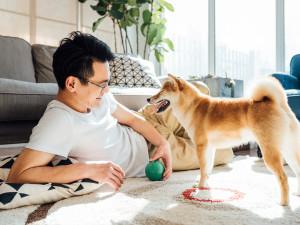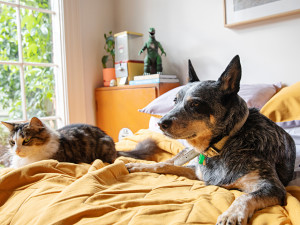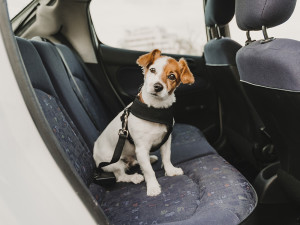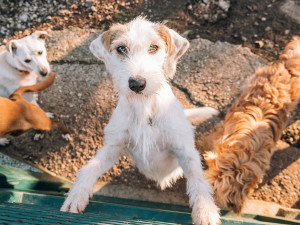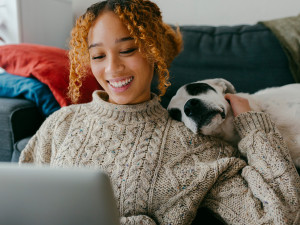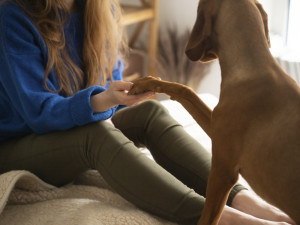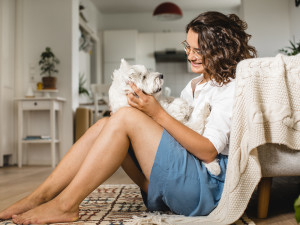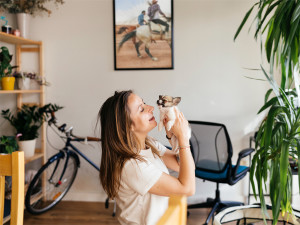Everything You Actually Need When You Get a New Dog
All the things you’ll want on hand as a new pet parent, from the must-haves to the nice-to-haves.
Congratulations, you’ve made the life-affirming decision to welcome a new dog into your home. To set yourself and your new pal up for success, there are some things it would be beneficial to have on hand. OK, it’s absolutely a ton of things. But when you’re equipped with a good checklist, you can eliminate much of the new-dog-parent guesswork and avoid wasting time and money on items that aren’t totally necessary for you and your pup.
To that end, we hopped on the phone with Amanda Farah, a certified dog trainer and the national training and behavior coordinator of Best Friends Animal Societyopens in new tab, and Shelby Semel, head of training and behavior at Animal Haven Shelteropens in new tab in New York City and founder of Shelby Semel Dog Trainingopens in new tab.
Trick question: All dogs are perfect! But find out which type is the best fit for you.
They both walked us through the nonnegotiable must-haves — that is, what you’ll absolutely need on-hand in those first few days and weeks of dog parenthood. They’ve also identified “highly, highly recommended” items, which are near-necessities or necessities for particular situations, as well as the “nice-to-haves,” i.e., some things that could make your pet parenting easier and may enrich your pet’s life but aren’t crucial to keeping them alive and well.
Many of Farah’s must-haves are not things one can buy at your local pet store. First and foremost, she recommends certain intangible things. These are to-do items like making sure the pet’s routine is in place and everyone in the household agrees to that routine, plus a few quiet days during which the dog is getting used to their new home — and not having to go to the vet or meet the neighbors. Both are intended to aid the transition for you and the dog (but mostly the dog).
How much do you spend on your pet per year?
“I think short of leash, collar, food bowl, a lot of the intangible must-haves are just more important at first,” Farah says. “If people are going to put financial investment into certain areas, that care and training are more priorities than a whole closet full of very fancy toys. We can DIY a lot of that stuff.”
Besides the intangibles, you can get most of the items that are recommended by Semel and Farah in one trip to your local pet store (support the little guy as much as you can!), or from online vendors. You will find no shortage of things to buy out there — the retail market for pets has exploded in the last 10 years — so read on to find out what you actually need.
Must Haves
Food
Specifically, the same food that they were eating at the rescue, shelter, or foster (just until you can make the transition to the food you want to feed them, at the guidance of your vet). “That way, there’s not too many transitions,” Semel says. “Make sure they have a good enough supply, so they don’t run out. The last thing you want on top of a dog that’s adjusting is for them to have stomach issues.”
Food and water dishes
We’ll let you in on a little-known secret: Dogs need somewhere for their food and water to go. Bowl technology has greatly improved over the years: There are bowls that grip the floor so they don’t move around and “slow feeder” bowls that encourage your dog to eat in a sensible amount of time. You can go for a classic bowl or talk to your vet about whether it would be good to get your dog a slow feeder to slow down those eager eaters.
Also, If you live in a climate that gets hot and/or plan on going on outdoor adventures with your dog, Farah says another must-have is a collapsible water bowl or a water bottle made specialopens in new tab for dogs.
Crate and/or pen and/or gate
Some method of containment is a must “for your safety, your apartment or a home’s safety, plus the dog’s safety,” Semel says. “When you’re bringing home a dog, you don’t necessarily know if there’s going to be any anxiety that's going to lead to chewing or disruptive behavior.”
Same thing with a younger dog. They could end up chewing something you do not want them to chew, like wires. “So [the pen or gate] can block off areas that you want to keep them out of, or it can be used as a containment area to keep them in one place when you're not able to watch,” she adds.
Every dog and every home is different, so choose one of these strategies according to your dog’s and/or the needs of your space. Farah recommends getting a crate especially if you’re bringing home a puppy.
“There will be times where they have to be confined, like at the vet or you may decide to travel,” she says. “Confinement for a dog that’s not accustomed to it is really stressful, so starting a puppy out with a safe space like a crate, even if you’re not going to use it for their entire life, it’s the kind thing to do.”
Likewise, exercise pens usually work best for small dogs or puppies. Larger dogs can usually jump over them. But there’s a fix for that, per Farah: “There are full-length baby gates now — it’s like a baby gate that’s essentially screen doors for your house — for big dogs.”
Treats
To humans, treats are largely just that: a little treat (like that warm chocolate chip cookie you definitely deserve on your way home from work). To dogs, they are essential for training. It’ll be crucial to have a few options of foods that (a) aren’t their everyday food, (b) are healthy, and (c) are exciting to your dog. Semel likes dehydrated blueberries or sweet potatoes, but there are loads of options available online and at pet stores. There’s definitely something there your dog will like.
You’ll use treats to reinforce good behavior, and not just for puppies. For a more mature dog, Semel says, “This isn’t a clean slate, right? They’ve already been to a couple of places; they’re going to need a little extra TLC. Making sure that you have things that they like and are ready and prepared to go a little extra out of the way to do some training and make sure that they are having fun and keeping their brains busy is important.”
Something to chew on
All dogs should have something to dig his or her teeth into. What exactly that is depends on the dog. Bully sticks are great but give some dogs diarrhea. Some strong-jawed pups have been known to swallow pig ears whole. Some dogs are intense chewersopens in new tab and need intense chew toys (KONG, for example, makes an “extreme” version of its classic toy). You’ll have to figure out what’s right for your dog.
One way to get ahead of the question so you can have something safe and interesting for your dog from day one, Semel says, is to reach out to the foster or rescue to see what your pup has had and liked. She also notes that puppies who are teething will probably go through more chews than older dogs, so it’s good to be over-prepared on this front.
Cleaning supplies
“It’s not if — but when — those messes are going to happen,” Farah says. An enzyme-based cleaner, such as Nature’s Miracle, is best. Paper towels or rags that are dedicated only to pet messes are also a good idea.
Nail clippers and a brush
Even if you plan to have the dog groomed professionally, both clippers and a brush are good to have on hand. Make the brush an appropriate one for the breed type.
Leash
A four- to six-foot leash is the way to go because, as Farah points out, “most places have a six-foot-leash law.”
Collar with ID and/or a harness
Age, lifestyle, and health issues will help you determine whether you should do a collar or a harness or both. An example of a collar only-option, Semel adds, is “if the dog is a little bit older or nervous with handling in any way, I would say stick with just a simple collar that you can just leave on all the time.” And vice versa: “Some dogs don’t like something around their neck or they have trachea issues or they're teeny tiny, and if they pull it, [they] start hacking.”
Your vet or trainer could help you narrow your options down, so you don’t waste money on buying the wrong thing. This brings us to:
The phone number for a trainer
Your trainer will be your lifeline. Not only will they help set you up for success with your new dog, no matter what age they are and what issues they come with, most trainers will likely be on hand to answer questions via text or email. Finding a trainer you like and trust prior to bringing a pup home is a great idea. Semel says, “Before adopting a dog, I like having a session already set up, even if it’s a 30 minute virtual session to be able to ask those questions.”
She means questions that even predate the formal training, like what harness is right for my dog? What is a brush that’s appropriate for my breed type? Something weird happened when Fido ate a pig’s ear, what gives? Expect to have a lot of these questions, and expect to have a trained expert (who is definitely not Dr. Google) to talk to about them.
Veterinary appointment
Vets are busier than ever these days, so don’t wait to set up an appointment, especially if you’re bringing home a puppy. They’ll need vaccinations and a series of wellness checkups.
You’ll also want to establish an emergency plan for your pet and your family, Farah notes. Is there an urgent care or an emergency vet clinic near you? Does everyone know the emergency plan?
“Before you get a dog is the best time to research [your care team],” including the vet, a groomer if you’re going to have one, and the trainer, Farah says.
Highly, highly recommended
Pet insurance
“As soon as possible,” Farah says, especially if the dog is a puppy, because it will ultimately be cheaper if you get pet insurance before any pre-existing conditions arise. Here’s a helpful guide to choosing the right pet insurance for your household.
Dog bed
You can technically use a regular pillow, blanket, or towel to ensure your dog is comfortable, but purchasing a bed is a great way to give them a place of their own. Again, you should buy the type of bed that’s right for your specific dog: “Particularly, a TempurPedic oneopens in new tab if the dog is older,” Semel says. “And if the dog is an intense chewer, and you’ve already been made aware of that, more along the lines of like a Kuranda bedopens in new tab — something that they can’t rip up and shred.”
An extensive variety of toys
Semel recommends having “20 to 30 interactive toys, stuffed toys, bones, and chews” that you give your dog in rotation (she likes the subscription boxes one can order for a dog because they guarantee novelty).
These are a necessity, because as Semel explains, “If [dogs] are not being given tasks and told what to do, many of them make their own choices, and sometimes they’re not ones we like.” Some examples? Barking, snacking on a favorite pair of shoes, etc.
“If you are giving them really fun activities, then they don’t really have the need to go try to do that,” she says. Kongsopens in new tab, Busy Buddyopens in new tab toys, The Pupsicleopens in new tab, snuffle matsopens in new tab, and the Nina Ottossonopens in new tab range of puzzles are good places to start.
Though it’s necessary to have enrichment toys, they are in the highly-recommended category because there are many ways to DIY interactive toys if you have the time and creativity to do so. This can be treats wrapped in newspaper, for example. Or kibble in a cardboard box or in pockets of a towel. But having a wide variety of exciting things to play with is essential for raising a well-adjusted dog.
Pee pads
Pee pads for puppies and for older dogs with bladder issues. This is especially relevant if the pet parent lives in an apartment rather than a house with a backyard. “Sometimes you need a backup,” Semel says.
Travel bag (for smaller dogs) and collapsible crate (for larger ones)
“If you have a smaller dog, a travel bag is great and I highly recommend them so you can take your dog more places and comfortably carry them,” Semel says, and adds to her list of highly-recommends, “a collapsible crate if you are planning on bringing your dog more places, getting them used to that early on.” With both of these, training them from the get-go and on not the day you have to get on a plane, train, or automobile is wise.
A ramp
This is for small breeds and especially ones with long bodies, like Dachshunds. “Back issues are expensive and painful,” Farah says.
Training them early on how to use a ramp or stairs to climb on the couch or bed could prevent back issues. And if those problems arise later in life, they’ll already be comfortable trotting on up.
Nice to have
Dog cam
You don’t have to buy a special camera for dogs (though if you do get one, we recommend Google Nest). There are appsopens in new tab that turn old phones into pet monitors, or you could set up your computer to monitor your pup when you’re away. But Semel does recommend having some way to monitor your pet while you’re gone.
“To be able to see what your dog is doing when you’re not home is very, very helpful,” Semel says. “You can’t diagnose any type of stress or any issues if you don’t know that they're happening. It’s good to make sure that your dog is relaxed when you’re not around.”
Farah adds that Wi-Fi cameras for dogs “moves up the list [to a must-have] if there are behavior issues because knowing the duration and intensity of those behaviors when you’re gone helps you work on the issues with a trainer.”
GPS dog collar
A GPS Dog Collar like the WhistleGoExploreopens in new tab is nice to have for its extra layer of security. Semel recommends it for dogs or puppies newly in your care because they can get spooked in new situations, and take off. A GPS collar is different from a microchip (which is also recommended) because it gives you as the pet parent more control in finding your lost dog.
“A microchip is great,” Semel says. “But the person who finds your dog has to bring it in to get that checked. So you can’t actually find a dog unless someone else has found it and brings it in.”
Car seat or seatbelt
“Some people just like their dogs riding in the car, and that’s not always bad, but I’d recommend some sort of car containment,” Farah says. Add a cover to protect the car from mess and extra doggie wear and tear. Plus, you’ll never forgive yourself if something happens to your dog in even the mildest of accidents. You need to wear a seat belt, and so do they.
Long line
A long lineopens in new tab, which also goes by long lead or dragline, is a leash that’s, well, really long. It can be useful for training or exploring the few areas that don’t have six-foot leash laws, Farah says.
She adds one caveat here: “I don’t mean a retractable. [Retractable leashes] can be really dangerous. I know someone who got their front teeth knocked out by one that failed. And it also breaks your leash training. If you’ve taught them not to pull on a leash and then they have to pull on a retractable to make it work, it’s very confusing to them.”
So, those are two things you don’t want to break: your dog’s training and your teeth.
Treat pouch or fanny pack
These can be good to store alongside your dog’s leash. It’s not an absolute necessity, but after a certain point, you will see the wisdom in having some kind of pouch.
“Lots of people just put treats in their pocket, and that’s OK, but the meat pocket gets a little gross after a while,” Farah says.
Nail clippers or a grinder
“Even if you don’t do your own grooming, there will be an occasion where they break a nail, and you need to do something about it,” Farah said. It’s useful to have a either clippers or a grinderopens in new tab on hand for when those moments arise.
Stroller or wagon
For if the dog that has mobility issues.
Rubber mat
To go under the food and water bowls. “I really like a rubber mat under the food and water bowls for young pups, because otherwise, they knock them over, and the whole thing gets wet and then they step in it, and then it’s a giant mess,” Semel says.
Toy box
You’re probably going to want to have something to contain all of your pet’s stuff. Those 20 to 30 enrichment toys will need to go somewhere. And bonus: Farah has even trained her dogs to put all of their toys back in the toy box once they’re done playing, and you can, too.
Some light reading on dog body language
There are plenty of good resources online and at your local library or bookstore that will help you understand and communicate with your dog.
“I think everyone should read Karen Pryor’s Don't Shoot the Dogopens in new tab,” Semel says, while Farah recommends Lili Chin’s Doggie Languageopens in new tab, especially if there are children in the household. Books on dog body language help humans identify “distance increasing behavior,” and help everyone identify and avoid any potentially traumatizing moments for the dog and the child.
“A lot of us, we grew up anthropomorphizing dogs, and relating their perception to our own, and dogs have an entirely different set of communications,” Farah says. “Especially those of us who grew up with dogs, we think we know what they’re saying, and sometimes we’re so wrong.”
With this list, permission granted to go forth and shop (and don’t forget to call your vet and a positive reinforcement trainer).


